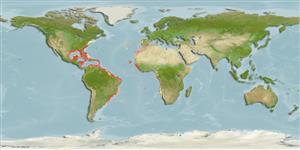Environment: milieu / climate zone / depth range / distribution range
Ecologia
marino associati a barriera corallina; distribuzione batimetrica 2 - 275 m (Ref. 4727), usually 3 - 30 m (Ref. 40849). Tropical; ? - 28°C; 43°N - 35°S, 98°W - 14°E
Western and Eastern Atlantic.
Length at first maturity / Size / Peso / Age
Maturity: Lm 23.0, range 20 - ? cm
Max length : 60.0 cm TL maschio/sesso non determinato; (Ref. 7251); common length : 30.0 cm TL maschio/sesso non determinato; (Ref. 5217); peso massimo pubblicato: 5.4 kg (Ref. 4699); Età massima riportata: 23 anni (Ref. 131113)
Spine dorsali (totale) : 3; Raggi dorsali molli (totale) : 29 - 32; Spine anali: 0; Raggi anali molli: 27 - 29. Greenish or bluish gray on back, orange-yellow on lower part of head and abdomen, with two broad diagonal curved bright blue bands running from snout to below and in front of pectoral fins, the lowermost continuous with a blue ring around lips; a broad blue bar across caudal peduncle, and blue sub-marginal bands in median fins (Ref. 13442).
Found over rocky or coral areas (Ref. 5217). May form schools, sometimes solitary over sand and grassy areas. Feeds mainly on benthic invertebrates (Ref. 4727). It preys on sea urchins by blowing water to overturn it and then attacks it where the spines are short (Ref. 9710). Excellent food fish but occasionally can cause intoxication due to the liver.
Robins, C.R. and G.C. Ray, 1986. A field guide to Atlantic coast fishes of North America. Houghton Mifflin Company, Boston, U.S.A. 354 p. (Ref. 7251)
IUCN Red List Status (Ref. 130435: Version 2024-1)
Can't connect to MySQL database (fbapp). Errorcode: Too many connections
